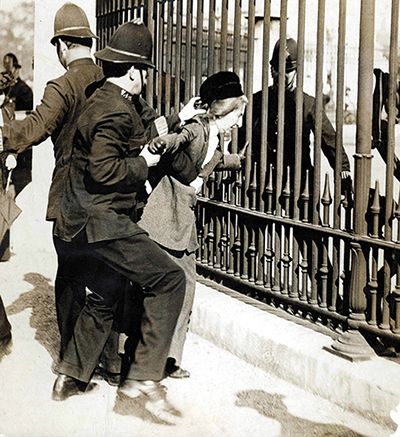2 Women’s suffrage: establishing a chronology
The term ‘suffrage’ means the right to vote in elections. Universal suffrage means that all adults (with a few exceptions) have the vote.
The struggle for women’s suffrage was inextricably linked with the fight for better working conditions for women. Women had often been brought into the factories because they were cheaper to employ than men.
Our popular image of this struggle to gain votes for women is of a militant activist, interrupting public meetings, chaining herself to railings and smashing windows, ready to go to prison in the name of her cause (Figure 3). These things certainly happened, but they don’t tell the whole story of the struggle, which lasted for decades and drew support from people from all classes and regions.
Activity 1 Finding out what happened when using a modern timeline
a.
1857
b.
1867
c.
1877
The correct answer is b.
Discussion
The National Society for Women’s Suffrage was set up in 1867. Lydia Becker was a founder member.
a.
1877
b.
1887
c.
1897
The correct answer is c.
Discussion
The NUWSS was set up in 1897. Millicent Fawcett was its leader.
a.
1903
b.
1913
c.
1923
The correct answer is a.
Discussion
The WSPU as formed in 1903 by Emmeline Pankhurst and her daughters Christabel and Sylvia.
a.
1908
b.
1913
c.
1918
The correct answer is c.
Discussion
Women over 30 were given the vote in 1918.
a.
1920
b.
1924
c.
1928
The correct answer is c.
Discussion
Women over 21 were not entitled to vote until 1928.
Task 2
In the text box below, or in your learning notebook, note down anything that surprised you when looking at the timeline.
Discussion
It’s surprising, if not a little shocking, that women in the UK didn’t gain the same voting rights as men until 1928 and that this happened long after the vote was granted to women elsewhere. Women gained the vote in Finland in 1906, for example, and in North America in 1919.
If you know anything about the struggle, it may well surprise you that there were many female suffragists who pre-dated the suffragettes. Suffrage campaigners had, from the 1860s onwards, argued for women to be granted a parliamentary vote on the same property-based franchise as men. Generally, they used constitutional methods and arguments. In 1897 the many local suffrage societies joined together to form the NUWSS and became, as a consequence, a force to be reckoned with.
It is crucial to note that a key element seems to have been the change from the peaceful protest advocated by the NUWSS to the much more active stance of the WSPU, which clearly felt that ‘deeds’ rather than ‘words’ were needed.
Note also that the campaign for women’s suffrage was not restricted to the suffragists and suffragettes. In addition to the information given in the timeline, in 1909 the People’s Suffrage Federation was formed to campaign for the extension of the vote to all adults – male and female – and it drew support from the trade unions and the Women’s Co-operative Guild. In 1910 the NUWSS put its weight behind the efforts of the Conciliation Committee, which sought to persuade members of all political parties to introduce a moderate franchise reform. Even the WSPU called a truce. A Conciliation Bill was brought before Parliament. There was certainly support from both sides of the House of Commons, although Herbert Asquith’s Liberal government didn’t believe there was sufficient support to enact a women’s enfranchisement bill. The Liberal government dissolved Parliament and when the same party returned to power, it focused on National Insurance (broad welfare reforms) designed to alleviate poverty. The members of the WSPU, despairing, broke the truce.

